Posted: 28 Feb 2012 02:09 PM PST  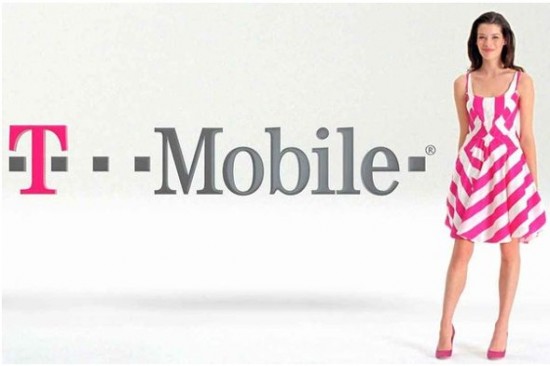 T-Mobile USA Senior Vice President Andrew Sherrad in an interview with The Verge, that the carrier would be skipping their original plans to introduce an even faster 84Mbps network, in favor of moving straight to an LTE based one. The move is for a few reasons. For one, T-Mobile wants to continue emphasizing their WiFi calling feature and currently, their UMA based service can’t support when a customer is on a WiFi call, and leaves their wireless network — the call will drop. But once T-Mobile gets on board the LTE train, this will no longer be a problem with the new network transitioning seamlessly between the two. That isn’t to say T-Mobile will just drop everything in their move to LTE. T-Mo will continue rolling out their plenty fast 42Mbps HSPA+ network while getting ready for LTE in 2013. And really, that network seems to be holding up pretty well compared to their nearest competitor, Sprint’s 3G/4G network. |
Posted: 28 Feb 2012 12:38 PM PST   Speaking at an investors conference, Verizon’s CTO Fran Shammo revealed that the long rumored “shared data family plans” will be made available to Verizon Wireless customers sometime in the middle of the year. Apparently, the carrier has spent a full year getting everything up and ready on their end. According to Shammo, the new plan wont include everyone at first with the carrier focusing on “long-term migration.” Instead, their new plans will be to made available for current 4G data subscribers initially. He also revealed that while Verizon is quick to advertise their blazing fast 4G LTE network in just about every television ad, realistically, only about 5% of their customers are actually using it. Verizon has long been trying to move their customers and adopt 4G with discounted handset incentives, promotions and marketing blitz. Verizon will continue rolling out their 4G network with plans to cover there entire 3G markets with 4G by 2013. This news will most likely be music to many a Verizon customers’ ears. Shared data with single account billing could prove much more affordable if done right and echoes competing carrier Sprint, who has offered unlimited shared data family plans for years now. Still, it makes you wonder, with only 5% of customers currently using 4G LTE, how will their network hold up with 40 or 50% of customers using up all that bandwidth? [FierceWireless] |
Posted: 28 Feb 2012 11:14 AM PST   In my review for the Samsung Galaxy Note, I mentioned Samsung was going to be pushing hard for S Pen integration in Android apps, but I didn’t know they were going to go this hard. Sammy announced that they’re throwing a friendly competition between app developers to see who can come up with the best way to integrate the S Pen into their existing app, or come up with an entirely original app form scratch. The winner will receive $205,000 in prizes, including a $100,000 cash prize. Even if your app isn’t all that good, you can still get a $2,000 cash prize plus a Galaxy Note for winning on honorable mention. Here’s the breakdown:
[GalaxyNoteSPenChallenge] |
Posted: 28 Feb 2012 10:05 AM PST   If you haven’t tuned into the tech blogosphere in the past few minutes, Apple has just sent out invites for their long rumored iPad 3 for a March 7th unveiling in San Francisco, CA. Apple fanboys and — a few Android ones too — are losing their gosh damn minds for this tablet and with good reason. This new iPad 3 is rumored to have a quad-core processor, constructed out of solid unicorn horn and if that above press invite is any indication, feature a high-def retina display. If there’s one thing I’ve noticed here in our comments or on various sites, there’s 2 things Android fans love. Their Cores, and their HD displays. With all that being said, I know there are more than a few Android fans who actually own both an Android smartphone and (gasp!) an iPad. Whether it’s because they like variety, or if they’re just plain ‘ol crazy in the head, it leaves me wondering: How many of you are looking forward to the iPad 3 and will most likely pick one up? It’s no secret Android tablets haven’t been selling so hot, and I’m sure many of you haven’t been buying them either. But I’ve oft wondered how many of our readers were closet iOS users, and will be picking up Apple’s latest tablet? Time for a viewer poll! Take Our Poll Don’t forget after voting, to leave your thoughts on why — or why not — you’ll be choosing the iPad 3 in addition to, or over the plethora of Android tablets currently available. Please, keep flaming to a minimum and insults or other derogatory statements will result in deletion. I’ve also dusted off my trusty ban hammer. I’ll be watching. |
Posted: 28 Feb 2012 08:53 AM PST   It’s time for your daily dose of Android gossip and if you’re a Sprint customer, you’re going to want to listen up. With the recent release of the insanely powered HD handsets toting LTE and top of the line specs, many Sprint customers have been feeling like they’ve been left in the dust. Well, seems the boys at PocketNow are hearing some murmurings of a new device — codenamed HTC Jewel — headed our way. Apparently, it will be along the lines of HTC’s all new One X handsets (think: HD display) but with slightly modified specs. Whereas the Evo 4G ushered in the short-lived era of Sprint’s 4G WiMax (to that one Chick-fil-a down the street), this new device will introduce Sprint customers to their all new LTE network. Needless to say, expect this device to make a pretty huge splash. Now, it may not be a long track record, but ever since the HTC EVO 4G was released, Sprint has released a new “Evo” device on its anniversary. Last year was the HTC EVO 3D and this year’s Evo? Yeah, HTC Jewel. The device, which is rumored to launch in time for the Evo’s 2nd birthday, will be perfectly timed to retain those original Evo users who find their contract expiring in just a few more months (like yours truly). We could hear more at CTIA in May but with Sprint’s CEO Dan Hesse making his first ever keynote at MWC on March 1st, maybe it will be sooner than later? What do you guys think? Will you bite if Sprint gives you an HTC Evo HD LTE? Or will it be too little, too late? Throw a kickstand on an HTC One X with S4 processor and I’ll be a happy camper. |
Posted: 28 Feb 2012 07:13 AM PST   The LG Optimus 4X HD was one of the better superphones shown off at MWC and the boys at Clove have confirmed with LG that the device will be headed to the UK. Priced at around £456 inc. VAT, they’ve already thrown up the 4X HD for pre-order on their site, with an expected launch data of this June. The bittersweet news (maybe all sweet for some) is that the follow up to last years Optimus 3D — the LG Optimus 3D Max — currently has no plans to launch in the UK and whether that changes sometime in the future remains to be seen. Can’t say I saw too many of you clamoring for this device so maybe that’s a good thing. [Clove Blog] |
Posted: 28 Feb 2012 06:37 AM PST  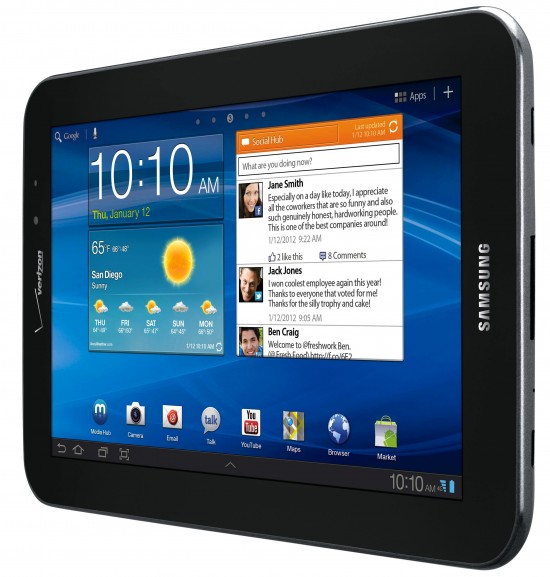 Touted as the world’s thinnest tablet, the Samsung Galaxy Tab 7.7 has officially been announced for Verizon Wireless and will be available at store near you, starting March 1st. The Galaxy Tab 7.8 features, you guessed it, a 7.7-inch Super AMOLED Plus display with 1280×800 resolution, 1.4GHz (unspecified) dual-core processor 3.2MP camera with LED flash, 2MP front facing camera, 16GB’s of internal storage with support for up to a 32GB micro SD card, Android 3.2 Honeycomb and running on Verizon’s blazing fast 4G LTE network. 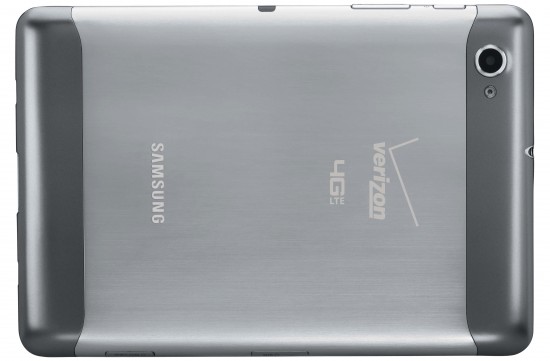 The 7.7 will be run you $500 with a 2-year agreement ($700 without) and mandatory $30 4G mobile broadband package for 2GB of data. You can check out the full press release below. BASKING RIDGE, N.J. - Announced at this year’s Consumer Electronics Show (CES), the Samsung Galaxy Tab™ 7.7 will be available in Verizon Wireless Communications Stores and online at www.verizonwireless.com starting March 1. Movies, pictures and games come to life in high-definition with the Samsung Galaxy Tab 7.7’s Super AMOLED™ Plus touchscreen display. Customers can quickly access the Web, stream music and more at blazingly fast speeds using the Verizon Wireless 4G LTE network combined with a 1.4 GHz dual-core processor and HTML 5 Web browser. |
Posted: 28 Feb 2012 06:34 AM PST   Samsung is continuing their line of WiFi-enabled media players with the introduction of the Galaxy S WiFi 4.2. The Galaxy S sans cellular radio was on the show floor here at MWC and we had the opportunity to check it out. Not much has changed since last years 4.7 and 5-inch models — you get Android 2.3 with all the official Google trappings including Android Market access and Google Mobile apps such as Gtalk. You get a 1GHz processor to run the show, a 2MP camera around the rear of the device, and a VGA front facing camera. The big difference here is the 4.2-inch WVGA display. Along with access to Google’s market of digital wares comes access to SamsungHub. Users get messaging functionality via Samsung’s ChatON. The phone is also DLNA compatible through Samsung AllShare and can act as a remote control with Samsung SmartView. The Galaxy S WiFi is designed to come in at an affordable price point so the mid-range specs aren’t surprising. If you want Super AMOLED, a hi-res display, and dual-core processing you are better off with an actual Galaxy S II, though the 4.2-inch media player could make a nice back up for longer trips. Much like the iPod Touch is to the iPhone, it’s hard to imagine most users needing both devices. This is more for the person without a smartphone looking for the same basic functionality (games, movies, apps, music) without the high price and monthly contract. |
Posted: 28 Feb 2012 06:05 AM PST  Some of us at Mobile World Congress have been hunting down the massive amount of Android collectible pins. For those of you who need something to keep track of what you’re finding, the Google team has an awesome app for you. Their Mobile World Congress application not only gives attendees information on developers featured at their booths and their hardware partners scattered throughout the Barcelona Fira, it also gives you an Android pins checklist. Through five days of last year’s Mobile World Congress, I managed to track down 13 of them. With as many as 86 different pins available this year you’re going to have to work hard to catch’em all – might as well grab this app just to make sure you aren’t doubling up. If you’re at Mobile World Congress let us know what you’ve found! [Market] Oh, and if you wanted to see what some of these pins look like in person, check some out in the pic below and be sure to find more on Android’s Google+ page!  |
Posted: 28 Feb 2012 06:00 AM PST  As the momentum of Mobile World Congress continues to grow and the gears continue to turn, Samsung wants you to remember that no one should pass up any of their Exynos-based products on the show floor. And you shouldn’t, really – it’s an awesome chipset.  But we’re curious: what makes you want to demand Exynos inside your next phone or tablet? Is it the insanely powerful GPU? The super fast dual-core (or soon-to-be quad-core) CPU? Its cool name? All of the above? Let us know in the comments section below before February 28th, 2012 at 11:59pm Eastern and you’ll be entered to win. Official list of rules and regulations below.
Disclaimer: This contest is sponsored by Samsung Exynos. |
Posted: 28 Feb 2012 05:43 AM PST   Verizon Wireless’s aggressive LTE rollouts are a continued effort, but they decided to take some time today to reflect on their progress so far. They boast that over 200 million Americans are covered with 4G, which is more than two-thirds of the population. They also went on to state that 5% of their consumer base, about five and a half million people, are on 4G LTE. While the percentage seems small, 5.5 million active 4G users is still quite impressive. Verizon will release no smartphone in 2012 without 4G LTE so they’re banking on getting even more people from 3G to 4G in the coming years as they complete their entire network rollouts by 2013′s end. Are you planning to make a switch to 4G soon? |
Posted: 28 Feb 2012 05:33 AM PST 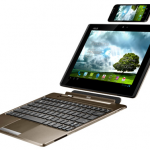 Loving gadgets can be an expensive hobby. While everyone might want a smartphone, a tablet, and a laptop, not everyone can afford all three. And if you’re going to buy all 3, why settle for anything but a seamless experience? The ASUS Padfone is my clear favorite for the best gadget of MWC 2012. It’s a fantastic concept that will save consumers money, offer greater seamlessness between devices, and the concept is executed beautifully. Regardless of whether you’re using the phone, the tablet, or the laptop, it’s the guts of the phone (Qualcomm MSM8260A Snapdragon S4 Krait dual-core 1.5GHz processor) that powers everything. However, each of the three components – the phone, tablet, and keyboard – all have their own battery. This makes perfect sense considering how quickly a tablet or laptop would drain the tiny battery of a smartphone, but the setup provides an added benefit: the tablet (6600 mAh battery) will power both the keyboard (unknown mAh) and phone (1520 mAh battery) when connected. Essentially, you’re tablet is also a backup battery source!      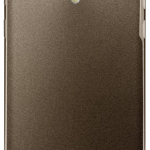 The PadFone runs Android 4.0 which is a blessing right off the bat. There appears to be some slight customizations, but nothing too offensive to the stock Android lover (this could change as individual carriers will surely dictate case-by-case). Pop your phone into the tablet and you’re running ICS on the tablet. Connect the keyboard and you’re suddenly trackpadding, clicking, and typing rather flawlessly. It’s always nice to have your devices sync… but when your one device IS three devices, no syncing necessary; you’ve already got everything you need. The Padfone screen is 4.3-inches with 960 x 540 pixel resolution and made of Gorilla Glass. It looks great. The whole phone is only 9.2mm thick, and while I was concerned with ASUS ability to produce a high-end PHONE, my fears were quickly quashed when I first held the PadFone in my hand. It looks great and feels great. The Padfone Station has a 10.1-inch screen with 1280 by 800 pixel resolution and is also made of Corning’s Gorilla Glass. I was incredibly impressed with the Padfone’s slim, light, but great feeling phone, but disappointed by the weight of the tablet portion. While docked in the keyboard the weight makes no difference, but if you’re only using the Padfone Station as a tablet it seems a bit cumbersome and heavy. I’ve seen one spec sheet read the station is 716g and another read 724g, neither indicate if that includes the keyboard dock or not. We’ll try to get more info on this and report back, but holding the tablet definitely feels on the heavy side. For comparison sake, the Motorola XOOM is between 708g and 730g depending on the model. Speaking of spec sheets, take a look at the one we snapped from the demo stand: 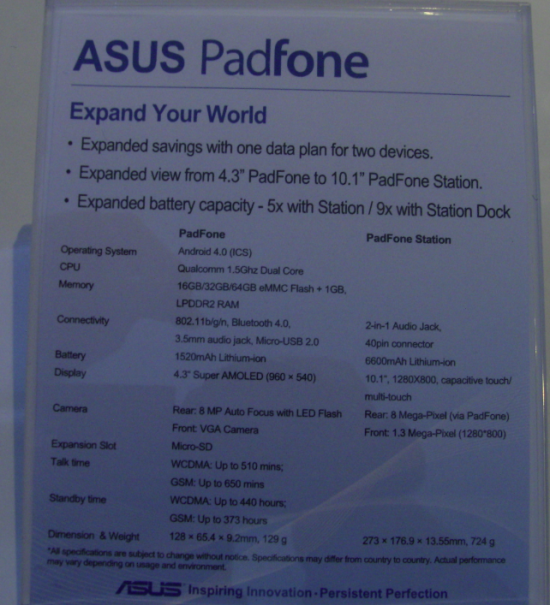 The Padfone has an 8MP camera with LED flash and can record in 1080p HD- total sweetness. When plugged into the tablet/dock, this rear facing camera is also used as the rear facing camera in the tablet/laptop. Both the Padfone and tablet have their own front-facing VGA cameras. One common question is sure to be, “can I use my phone for voice calls when it’s plugged into the tablet/laptop?” You sure can, and that’s one of the more unique features on an already unique device. The Padfone Station comes with a stylus. That stylus has an on/off button along with volume up/down, an earpiece and a microphone. Answer your call and/or make your call, turn the stylus on and hold it up to your head just like it’s a regular phone. Pretty darn cool, right? Pricing and availability of the Padfone is still completely up in the air and will depend on the region and carriers. Whether or not carriers will allow consumers to purchase only the Padfone or only the Padfone and tablet is unknown; again, this simply depends on the individual carriers and what they choose to offer. I’m hoping North American carriers jump on the Padfone but I’m nervous they’ll take a pass: they make a lot more money by selling phones, tablets, and laptops individually and trying to sell data plans to consumers for each. ASUS is hooking consumers up with an opportunity to seamlessly converge what are normally three separate devices. The concept is tremendous in theory and seems to work wonderfully in reality as well- that’s something we’re eager to test in a full review. It’s also great to see the ingenuity and innovation of manufacturers shining in the Android World… the ASUS Padfone and Padfone Station are a prime example of what makes Android such an amazing operating system. This is why I love Android. |
Posted: 28 Feb 2012 05:29 AM PST  It was only yesterday that we’d spotted jelly beans being offered to folks behind closed doors. If not for the fact that the next letter for the next version of Android is J, people put two and two together to suggest that Android Jelly Bean would be the codename for the next major version of Android. Of course, we wanted to know a lot more than just its name.  According to Computerworld, though, we now have a launch window to go along with that name. Hiroshi Lockheimer mentioned to them that the new version of Android would release this fall. As you know, Android 4.0 was announced in October and released in November, so it’s likely we’ll be seeing Jelly Bean in that same window. Unfortunately, that’s all we have. It’s the most we can ask for, though, as we usually aren’t let in on even the most basic information until we’re close to the announcement. So there you have it. Nexus owners should expect the update close to when it is announced, of course, and everyone else is still waiting on Ice Cream Sandwich. Oh well. [via TC] |
Posted: 28 Feb 2012 05:13 AM PST 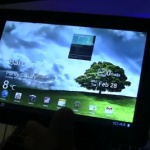 The Transformer Prime may have been the most powerful tablet on the market for a bit, but it has a younger, strong brother coming to take over the task of protecting the family. We got our hands on the ASUS Trasnformer Pad Infinity (700 series). The device will be positioned above the Transformer Prime and it’s for some very good reasons. To start, the 10.1 inch Super IPS+ display has 600 nits of brightness and will by a Full HD display (1920×1200). It’ll house 1GB of RAM, 32-64GB of internal storage with expansion options and will have an 8 megapixel rear camera which can shoot HD video. The front camera has gotten a slight upgrade from the Transformer Prime, as well – it has a 2 megapixel sensor over the latter’s 1.3 megapixel sensor. It’s extremely thin for a tablet, as well, with its 8.5mm brushed metal chassis. Unfortunately, we’re not so sure what’s going on with its processor. ASUS is touting that it will either have NVIDIA’s Tegra 3 quad-core processor or Qualcomm’s Snapdragon S4 dual-core processor. You’ll be getting NVIDIA’s quad-core Tegra 3 monster if you opt for the WiFi version, Qualcomm’s dual-core MSM8260A S4 Snapdragon processor if you want 3G, and Qualcomm’s dual-core MSM8960 s4 Snapdragon processor if you’re getting an LTE version. It’s unfortunate that the processor make and model are inconsistent between the different models. We’d undoubtedly opt for NVIDIA’s Tegra 3 on all three models but I guess ASUS has its reasons. Find the video hands-on embedded above. |
Posted: 28 Feb 2012 05:07 AM PST  Most of MWC’s major announcements have already been had, but tucked in the Fujitsu booth we found an Android prototype that made quite the impression on us thanks to an obnoxiously sick set up specs: Quad-Core NVIDIA Tegra 3 Processor, Android 4.0 ICS, 4G LTE connectivity, 13.1MP camera, and oh yeah- it’s waterproof. We didn’t get to test out it’s waterproof endurance, but as witnessed in our Fujitsu Arrows videos from CES, the company is making all their devices waterproof. It does indeed work well and I completely commend the waterproofing effort on behalf of clumsy consumers (like me) around the world. Take a look at these pics I snapped with the 13.1 MP camera of the “Fujitsu F12 Arc” as it’s named in the Android system settings (click to enlarge): 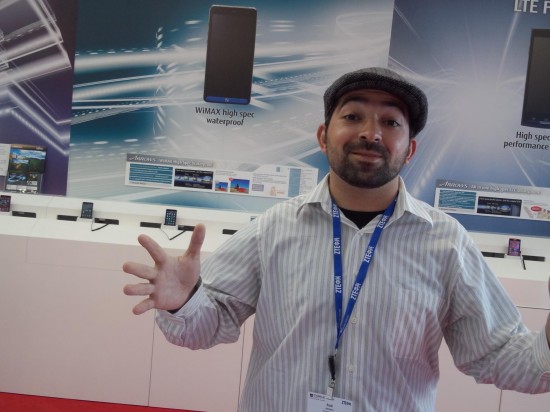 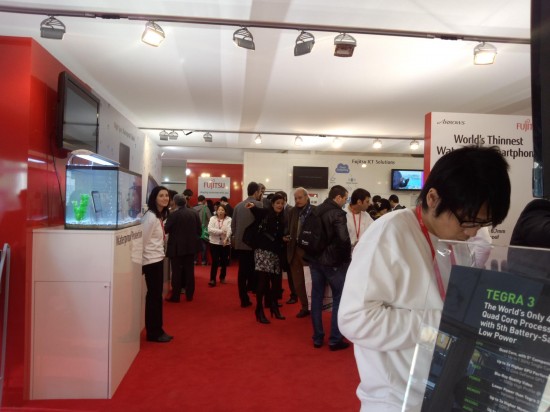 Hmmm… I wonder if that girl is smiling at me or Quentyn? Either way, the photos turned out pretty good, but appear a bit suspicious. We snapped the pictures, transferred them to Quentyn’s Galaxy Nexus via Bluetooth, and they’re only 2048px by 1536px in resolution. Doing a little pixel to resolution math, we learn that’s the resolution of a 3.1MP and not a 13.1MP camera. Typo? Prototype mistake? Or maybe we didn’t set up the camera for optimal photo quality? The rear of the phone clearly states it’s a 13.1MP device on the outer lens of the camera, so we’ll look into this and let you know. Check this article in a few hours and we’ll have an update. UPDATE: Fujitsu said the prototype had not been configured to allow the 13.1MP sensor to work with Android 4.0 so was limited to 3MP output until further development. They did have other Android devices with 13.1MP cameras and the same sensors and we’ve provided a photo sample below (click to enlarge) for reference purposes: 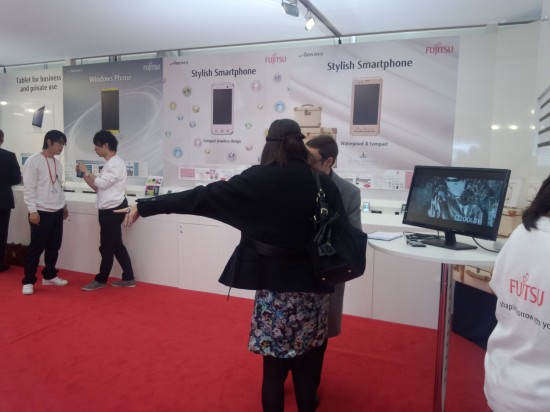 The “prototype” status was definitely affecting several features. We attempted to take video, but the display appeared to freeze and the recording played back was merely a green box. Below the camera is a fingerprint sensor, used to lock and unlock your device by reading your fingerprint so that nobody else can access your phone should you choose. Unfortunately, this is another feature that was found on the hardware yet not working on the software. Perhaps most notable and noticeable on this Fujitsu phone was the beautiful 4.7-inch screen working in harmony with the Quad-core interior and Android 4.0 exterior. It’s a beautiful thing to see all these manufacturers embracing quad-core android 4.0 gear… now if they’d just follow Fujitsu’s lead and waterproof everything, we’d be in much better shape. |
Sunday, April 15, 2012
Update - 91
Subscribe to:
Post Comments (Atom)
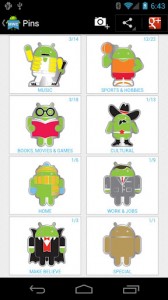
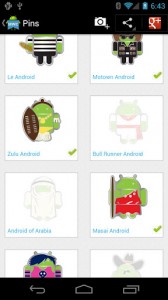
No comments:
Post a Comment